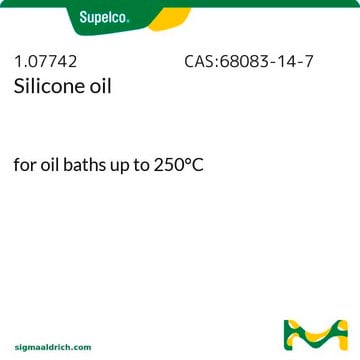All Photos(2)
About This Item
Linear Formula:
[-Si(CH3)2O-]n
CAS Number:
MDL number:
UNSPSC Code:
12162002
NACRES:
NA.23
Recommended Products
vapor density
>1 (vs air)
vapor pressure
<5 mmHg ( 25 °C)
5 mmHg ( 20 °C)
form
viscous liquid
refractive index
n20/D 1.403 (lit.)
viscosity
30,000 cSt(25 °C)
bp
>140 °C/0.002 mmHg (lit.)
density
0.971 g/mL at 25 °C
Looking for similar products? Visit Product Comparison Guide
Related Categories
Storage Class Code
10 - Combustible liquids
WGK
WGK 1
Flash Point(F)
214.0 °F - closed cup
Flash Point(C)
101.1 °C - closed cup
Personal Protective Equipment
dust mask type N95 (US), Eyeshields, Gloves
Choose from one of the most recent versions:
Already Own This Product?
Find documentation for the products that you have recently purchased in the Document Library.
Customers Also Viewed
John R Fowler et al.
The Orthopedic clinics of North America, 44(3), 425-431 (2013-07-06)
Radial head fractures without associated bony or ligamentous injury can be safely treated with internal fixation, if possible, or arthroplasty if nonreconstructable. However, nonreconstructable radial head fractures in association with elbow dislocation and/or ligamentous injury in the elbow or forearm
M Krutyeva et al.
Physical review letters, 110(10), 108303-108303 (2013-03-26)
We present neutron spin echo experiments that address the much debated topic of dynamic phenomena in polymer melts that are induced by interacting with a confining surface. We find an anchored surface layer that internally is highly mobile and not
Kristina Kreppenhofer et al.
Langmuir : the ACS journal of surfaces and colloids, 29(11), 3797-3804 (2013-02-23)
Here we demonstrate the generation of polymer monolithic surfaces possessing a gradient of pore and polymer globule sizes from ~0.1 to ~0.5 μm defined by the composition of two polymerization mixtures injected into a microfluidic chip. To generate the gradient
Daniel T Ginat et al.
JAMA otolaryngology-- head & neck surgery, 139(2), 199-201 (2013-02-23)
Silastic implants are popular for cosmetic cheek augmentation. We describe the computed tomographic (CT) and magnetic resonance imaging (MRI) findings in 5 cases (4 patients) with penetration of the medial aspect of Silastic cheek implants through the anterior maxillary sinus
Karthik R Balakrishnan et al.
Lab on a chip, 13(7), 1302-1307 (2013-02-07)
Resistive-pulse sensing (RPS), which is based on measuring the current pulse produced when a single particle transits a pore or channel, is an extremely versatile technique used to determine the size and concentration of cells and viruses and to detect
Our team of scientists has experience in all areas of research including Life Science, Material Science, Chemical Synthesis, Chromatography, Analytical and many others.
Contact Technical Service


